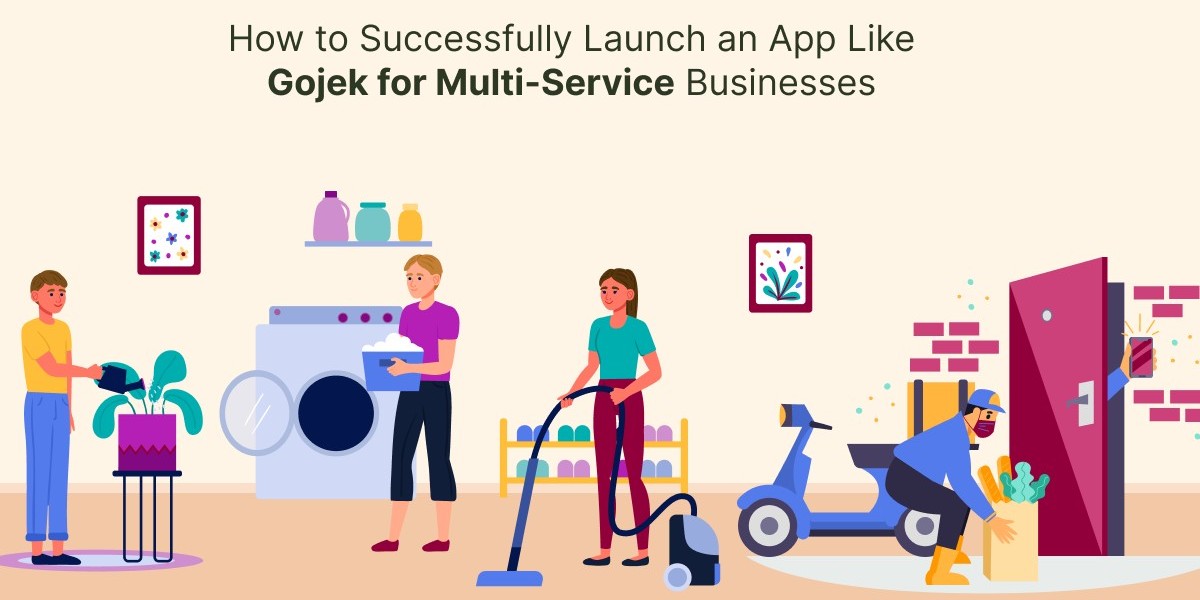Multi-service apps like Gojek have changed the way people access daily services. From ride-hailing to food delivery, home services, and payments, these apps offer convenience in one place. Entrepreneurs and startups are increasingly interested in launching similar platforms to tap into this growing market. However, building a multi-service app is not just about technology; it requires careful planning, market research, and a solid business model. In this blog, we will guide you on how to successfully launch an app like Gojek, step by step, and explain how to make it sustainable in the long run.
Understanding the Multi-Service App Concept
A multi-service app combines multiple services under a single platform. Users can book rides, order food, schedule home services, or send packages without switching between different apps. The key advantage of this model is convenience. For businesses, it creates opportunities to earn revenue from multiple streams.
Why Multi-Service Apps Are Popular
Customers today value speed and simplicity. Instead of using separate apps for different services, they prefer one platform that handles all needs. Multi-service apps also allow businesses to cross-sell services, increase engagement, and build loyalty.
Key Components of a Multi-Service App
To launch a successful app like Gojek, you need to focus on three main components: the user app, the service provider app, and the admin panel. The user app lets customers browse services and place orders. The service provider app helps providers accept requests and manage their work. The admin panel allows the business to manage operations, track earnings, and analyze performance.
Planning Your Multi-Service App
The first step in launching an app like Gojek is planning. You must define your target audience, understand their needs, and decide which services to include initially. Start small with the most in-demand services and expand gradually.
Market Research
Research is crucial to understand competition, user behavior, and market gaps. Study existing apps and identify what works well and what can be improved. Talk to potential users to learn about their pain points and expectations.
Choosing the Right Services
While Gojek offers a wide range of services, a new business may not be able to launch all at once. Start with core services like ride-hailing, delivery, or home services, then add additional services as the platform grows. This approach ensures quality and reduces operational complexity.
Revenue Model
Decide how your app will earn revenue. Multi-service apps typically generate income through commissions on each transaction, subscription plans for service providers, in-app advertising, and premium services. A clear revenue strategy helps attract investors and ensures sustainability.
Developing the App
Once planning is complete, the next step is development. The quality of the app determines the user experience, which is critical for retention and growth.
Choosing the Right Technology
Select a technology stack that is scalable and secure. Your app must handle multiple services, support real-time tracking, and manage secure payments. Many businesses opt for ready-made solutions like a gojek clone app to save development time and reduce costs.
User-Friendly Interface
The app should be simple and intuitive. Customers should be able to book services in a few taps, track their orders, and make payments easily. Service providers should find it easy to accept requests and manage schedules.
Testing and Quality Assurance
Before launch, the app must be tested thoroughly. Check for bugs, glitches, and usability issues. Test different scenarios to ensure smooth functioning under various conditions. Quality assurance builds trust and prevents negative reviews.
Launching Your Multi-Service App
Launching the app involves more than just making it available in app stores. Marketing, customer acquisition, and operational readiness are equally important.
Marketing Strategy
Create a marketing plan to attract users and service providers. Use social media, local promotions, and referral programs to generate interest. Highlight the convenience and variety of services your app offers.
Onboarding Service Providers
Service providers are the backbone of your app. Make it easy for them to join, provide proper training, and support them with tools to manage requests efficiently. Motivated and well-supported providers improve customer satisfaction.
Customer Support
Offer 24/7 support to handle queries, complaints, and feedback. Good customer service builds trust and encourages repeat usage.
Scaling Your Multi-Service App
Once the app is launched and running smoothly, the focus shifts to growth and scalability.
Adding More Services
Gradually introduce additional services based on user demand and operational capacity. Expansion should be controlled to maintain quality and reliability.
Read More: How Gojek Clone Apps Help Businesses Cut Costs and Boost Revenue
Geographic Expansion
Move into new cities and regions to increase your user base. Conduct local market research to understand regulatory requirements and customer preferences.
Technology Upgrades
As the user base grows, update your app to handle increased traffic. Add new features like AI-based recommendations, chat support, or loyalty programs to enhance user experience.
Partnerships and Collaboration
Collaborate with businesses, restaurants, delivery providers, and service professionals to increase service options and reach. Partnerships can also help reduce operational costs.
Challenges to Expect
Launching a multi-service app comes with challenges such as stiff competition, regulatory hurdles, and managing multiple service providers. Keeping customer satisfaction high while expanding services is also challenging. However, with proper planning, technology, and operational management, these challenges can be overcome.
Competition in the Market
The on-demand service market is highly competitive. To succeed, focus on providing superior user experience, unique offerings, and reliable service.
Managing Operations
Coordinating multiple services, payments, and providers can be complex. Use a robust admin panel and efficient management tools to streamline operations.
Ensuring Safety and Compliance
Ensure that all service providers are verified and trained. Follow local regulations for transportation, delivery, and other services to avoid legal issues.
Conclusion
Launching an app like Gojek requires careful planning, quality technology, and a strong operational strategy. By starting with core services, building a scalable platform, and focusing on user experience, entrepreneurs can create a successful multi-service app. Revenue can be earned through commissions, subscriptions, advertising, and premium services. For businesses looking to enter the on-demand market quickly, using ready-made solutions like an uber clone app can save time, reduce costs, and accelerate launch. Understanding these steps helps startups avoid common pitfalls and scale their platforms effectively.
Frequently Asked Questions
What is a multi-service app?
A multi-service app offers different services like ride-hailing, food delivery, home services, and more under one platform for user convenience.
How does an app like Gojek earn money?
It earns revenue through commissions on services, subscription plans for providers, in-app advertising, and premium services.
Can startups launch all services at once?
It is better to start with core services and expand gradually to maintain quality and reduce complexity.
How important is technology for a multi-service app?
Technology is critical for real-time tracking, secure payments, scalability, and smooth user experience.
Is using a ready-made solution helpful?
Yes, ready-made solutions like an uber clone app can save development time, reduce costs, and allow faster launch while maintaining quality.








